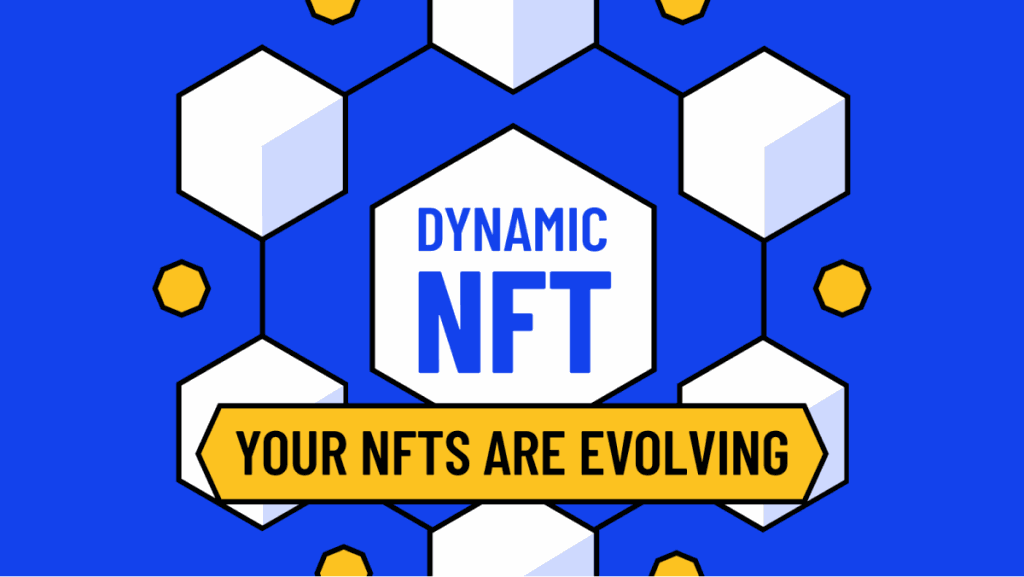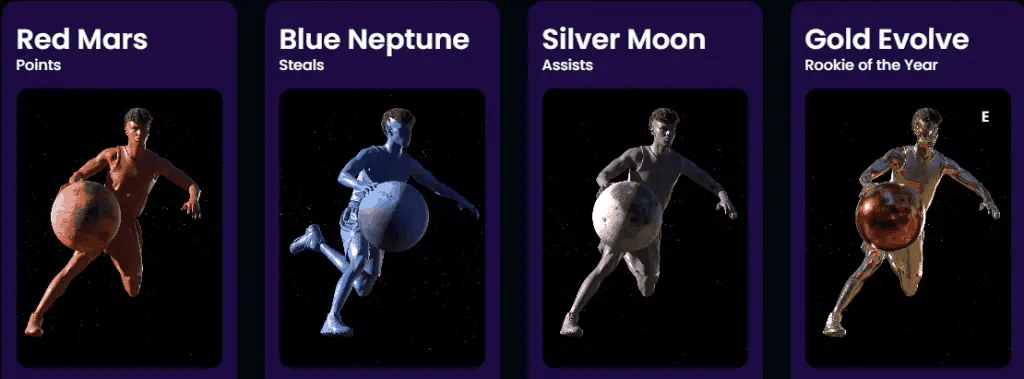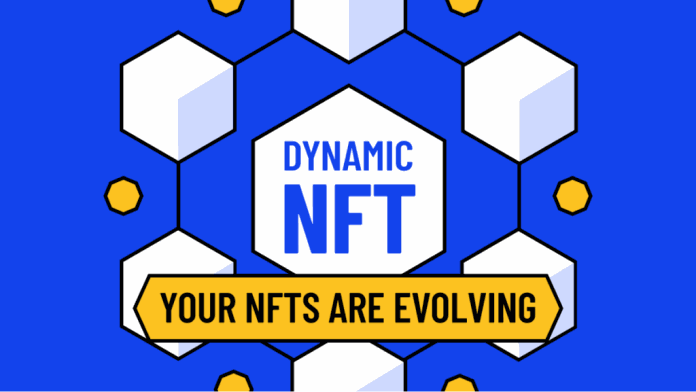
NFTs, or non-fungible tokens, are unique digital assets representing ownership of various items, such as art, music, games, or collectibles. NFTs are stored on the blockchain and can be verified, traded, and sold without intermediaries.
However, not all NFTs are static; some can change their characteristics over time based on certain conditions or triggers. These are called dynamic NFTs (dNFTs), offering more possibilities and flexibility for creators and collectors. This article will explain dynamic NFTs, their work, and some use cases and examples of this emerging technology.
What are Dynamic NFTs?
Dynamic NFTs are NFTs can change their metadata when certain conditions are met. Metadata is the information that describes the characteristics of an NFT, such as its name, description, image, attributes, etc.
For example, an NFT of a digital painting can have metadata that includes the title, artist, date, style, color palette, etc. Dynamic NFTs can alter their metadata based on external data or events, such as the weather, the time of day, the price of a cryptocurrency, the outcome of a game, etc. This means that dynamic NFTs can evolve, adapt, or react to the real or virtual worlds in which they exist.
Dynamic NFTs work by using:
- Smart contracts
- Decentralized oracles
Smart contracts are self-executing programs that run on the blockchain and enforce the rules and logic of an NFT. Decentralized oracles provide reliable and secure data from outside sources to smart contracts. By combining smart contracts and decentralized oracles, dynamic NFTs can encode logic that automatically updates their metadata based on external data or events.
For example, a dynamic NFT of a flower can use a smart contract to change its color based on the temperature data provided by a decentralized oracle.
Dynamic NFTs have many potential use cases and examples in various domains and industries. Some of them are:
- Gaming: Dynamic NFTs can enhance the gaming experience by creating items that change according to the game state, the player’s actions, or the environment. For example, a dynamic NFT of a sword can increase its power when the player defeats a boss, or it is nighttime in the game world.
- Art: Dynamic NFTs can create interactive, responsive, or generative artworks. For example, a dynamic NFT of a painting can change its style based on the viewer’s mood or the music playing in the background.
- Sports: Dynamic NFTs can create collectibles that reflect the performance or achievements of athletes or teams. For example, a dynamic NFT of a basketball card can update its stats based on the latest game results or increase its rarity when the player wins an award.
- Music: Dynamic NFTs can create songs that vary depending on the listener’s preferences or context. For example, a dynamic NFT of a piece can change its genre based on the listener’s mood or location.
- Fashion: Dynamic NFTs can create clothing or accessories that adapt to the wearer’s style or environment. For example, a dynamic NFT of a jacket can change color based on the weather or the season.
- Social media: Dynamic NFTs can create avatars or profiles that express the user’s personality or status. For example, a dynamic NFT of an avatar can change its appearance based on the user’s emotions or activities.
Dynamic NFTs are an exciting and innovative development in blockchain and digital art. They offer new ways to create, own, and enjoy digital assets that are more engaging and personalized than ever before.
What is Static NFT?
Static NFTs are NFTs have fixed metadata that does not change over time or are based on external data or events. For example, an NFT of a digital painting can have metadata that includes the title, artist, date, style, color palette, etc. Static NFTs have immutable and permanent metadata once minted on the blockchain. This means that static NFTs do not evolve, adapt, or react to the real or virtual worlds in which they exist.
Static NFTs work by using smart contracts and decentralized storage. Smart contracts are self-executing programs that run on the blockchain and enforce the rules and logic of an NFT. Decentralized storage is a service that provides secure and distributed storage for the data of an NFT, such as its image or audio file. By combining smart contracts and decentralized storage, static NFTs can store their metadata and data on the blockchain and ensure their authenticity and provenance.
Static NFTs have many advantages and disadvantages in various domains and industries. Some of them are:
Advantages
- Static NFTs are simple and easy to create and understand. They do not require complex logic or data sources to function.
- Static NFTs are reliable and consistent. They do not depend on external factors or events affecting their quality or availability.
- Static NFTs are timeless and classic. They preserve the original vision and intention of the creator and do not change with trends or preferences.
Disadvantages
- Static NFTs are limited and rigid. They do not offer much flexibility or customization for the creator or the collector.
- Static NFTs are boring and repetitive. They do not provide much interaction or engagement for the user or the audience.
- Static NFTs are outdated. They do not keep up with the innovation and development of technology and society.
- Static NFTs are the most common and traditional form of NFTs. They offer a simple and reliable way to create, own, and enjoy digital assets that are unique and authentic. However, they also have some drawbacks that may limit their potential and appeal in the future.
Dynamic NFTs vs Static NFTs
The main differences between dynamic NFTs and static NFTs are:
- Dynamic NFTs can change their metadata over time or based on certain conditions or triggers, while static NFTs have fixed metadata that does not change.
- Dynamic NFTs use smart contracts and decentralized oracles to update their metadata based on external data or events. In contrast, static NFTs use smart contracts and decentralized storage to store their metadata and data on the blockchain.
- Dynamic NFTs offer more possibilities and flexibility for creators and collectors, while static NFTs are simple and reliable.
- Dynamic NFTs can evolve, adapt, or react to the real world or the virtual world in which they exist, while static NFTs preserve the original vision and intention of the creator.
Step by step of how to create a Dynamic NFT
To create a dynamic NFT, you will need to use smart contracts and decentralized oracles. Smart contracts are self-executing programs that run on the blockchain and enforce the rules and logic of an NFT. Decentralized oracles provide reliable and secure data from outside sources to smart contracts. By combining smart contracts and decentralized oracles, you can encode logic that automatically updates your NFT’s metadata based on external data or events.
There are different ways to create dynamic NFTs, depending on the platform and the data source you want to use. Here are some possible steps to create a dynamic NFT using Ethereum, IPFS, and Chainlink:
- Set up the ERC721 token: ERC721 is the standard for creating NFTs on Ethereum. You will need to write a smart contract that implements the ERC721 interface and defines the essential functions of your NFT, such as minting, transferring, and querying.
- Upload the NFT image links in the IPFS URIs: IPFS is a decentralized storage system that allows you to store and access files without relying on a central server. You will need to upload your NFT images to IPFS and get their unique identifiers (URIs). These URIs will be used as part of your NFT’s metadata.
- Complete a compile check: You must compile your smart contract code using a tool like Remix or Truffle and check for errors or warnings.
- Make the NFT contract “Keepers Compatible”: Chainlink nodes monitor and execute smart contract functions based on predefined conditions. You will need to make your NFT contract compatible with Keepers by adding some annotations and modifiers to your code.
- Have the smart contract interact that will change the NFT based on your defined variables: You will need to write a function in your smart contract that will update your NFT’s metadata based on some variables that you determine. For example, you can use Chainlink’s external API call feature to get data from a weather API and use it to change your NFT’s color based on the temperature.
- Test your dNFT to see if it is dynamically updating as expected: You will need to deploy your smart contract to a test network like Rinkeby or Kovan and mint some dNFTs using a tool like MetaMask or Etherscan. You must also fund your contract with LINK tokens to pay for the Oracle services. You can then check if your dNFTs are updating their metadata according to the data provided by Chainlink.
- Mint and deploy your dNFTs: Once satisfied with your testing results, you can deploy your smart contract to the leading network and mint your dNFTs for real. You can also list them on a marketplace like OpenSea or Rarible and sell them to other collectors.
These are general steps for creating dynamic NFTs using Ethereum, IPFS, and Chainlink.
Tool required to create dynamic NFTs
Some tools that are necessary for creating dynamic NFTs (dNFTs) are:
- A blockchain platform that supports NFT standards and smart contracts, such as Ethereum, Polygon, or Binance Smart Chain.
- A decentralized storage system that allows you to store and access your NFT images or files, such as IPFS or Arweave.
- A smart contract development tool that allows you to write, compile, and deploy your NFT logic, such as Remix, Truffle, or Hardhat.
- An oracle service that provides reliable and secure data from outside sources to your smart contracts, such as Chainlink or Band Protocol.
- A wallet or browser extension that allows you to interact with your NFTs and the blockchain, such as MetaMask or WalletConnect.
- A marketplace or platform allows you to mint, list, and sell your NFTs, such as OpenSea, Rarible, or Foundation.
These are some of the general tools that are required for creating dynamic NFTs. However, depending on the specific features and functionalities of your dNFTs, you may need additional tools or services.
For example, if you want to create dNFTs based on real-time weather data, you may need to use a weather API that can provide data to your smart contracts via Oracle. If you want to create dNFTs based on verifiable randomness, you may need to use a service that can generate provably fair random numbers for your smart contracts, such as Chainlink VRF.
Specific examples of dynamic NFTs
Some examples of dynamic NFTs are:
- LaMelo’s NFT collection: NBA player LaMelo has introduced a collection of dynamic NFTs that reflect his performance and offer various benefits to their holders. For example, when he won the Rookie of the Year for the 2020-2021 NBA season, the NFT changed color to gold, and the planet Saturn he held transformed into the sun.

- CryptoKitties: CryptoKitties is an NFT-based game that allows players to buy, sell, and breed digital cats. Each cat has its unique appearance and traits determined by a genetic algorithm. The cats can also change their features based on breeding or environmental factors.
- The Merge: The Merge is a dynamic NFT artwork that consists of two parts: a digital painting and a physical painting. The digital painting changes its appearance based on the weather data of the location where the physical painting is displayed. The physical painting also changes its appearance based on the temperature and humidity of its environment.
- Async Art: Async Art is a platform that allows artists to create programmable art that can change over time or based on user input. Each artwork comprises multiple layers that the artist or the collector can control. For example, an artwork can change its color based on the time of day, the season, or the viewer’s mood.
- Organic Growth Crystal Reef: Organic Growth Crystal Reefs are dynamic NFTs that evolved and are based on transactions. In 3 months set by the developers, crystals would grow their traits and change how they look based on time and transaction.
- Pearpop’s dynamic NFTs: Pearpop is a platform that allows creators to mint NFTs from their social media posts and rank them based on their popularity. The NFTs can change their appearance and value based on the number of likes, comments, shares, or views they receive.
These examples of dynamic NFTs show how they can create more engaging and personalized digital assets.
Conclusion
Dynamic NFTs (dNFTs) are a new and exciting form of digital assets that can change their characteristics over time or based on certain conditions or triggers. They offer more possibilities and flexibility for creators and collectors, as they can create more engaging and personalized experiences.
Different platforms and tools can help create dynamic NFTs, such as Ethereum, IPFS, Chainlink, OpenSea, etc. Dynamic NFTs have many potential use cases and examples in various domains and industries, such as gaming, art, sports, music, fashion, social media, etc.
Dynamic NFTs are an innovative and promising development in the field of blockchain and digital art, and they may revolutionize the way we create, own, and enjoy digital assets in the future.


